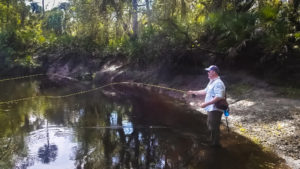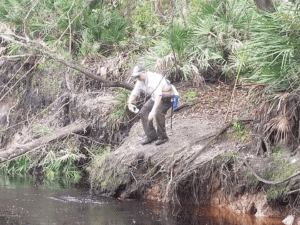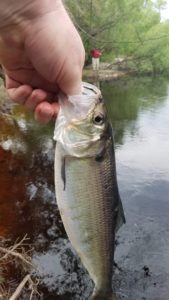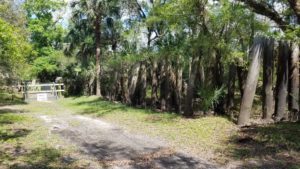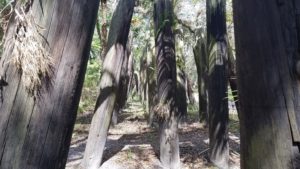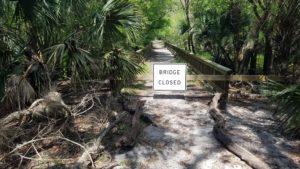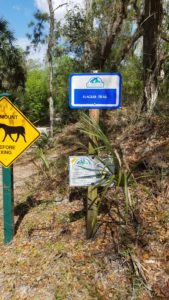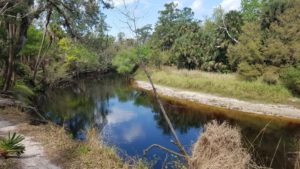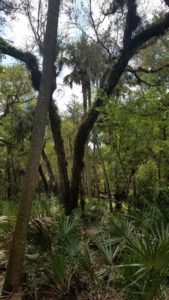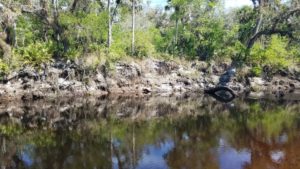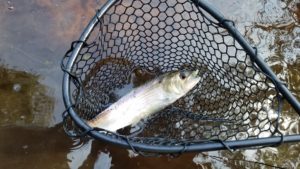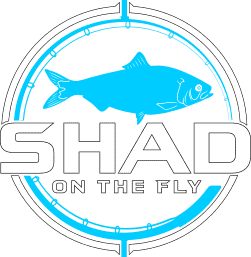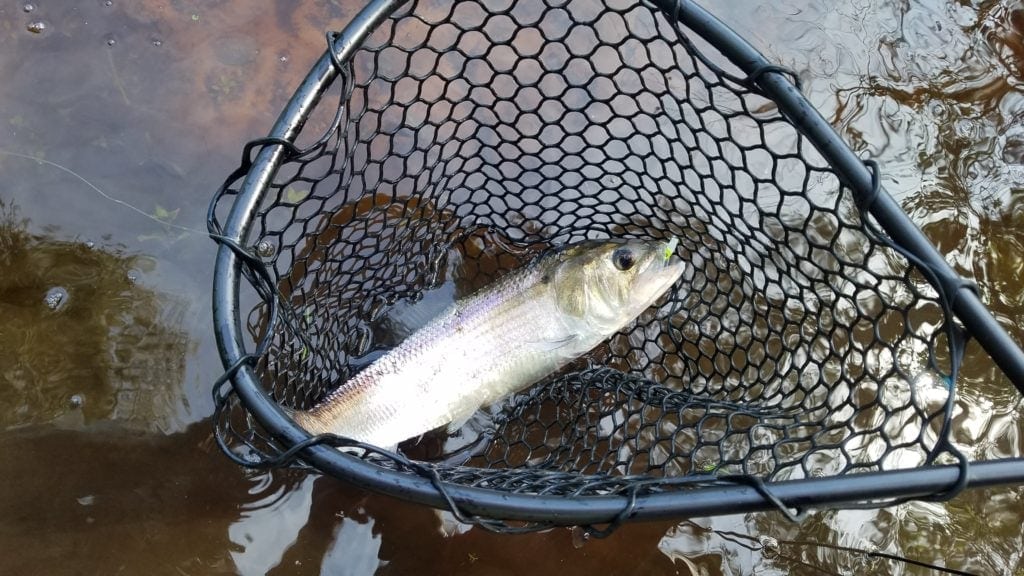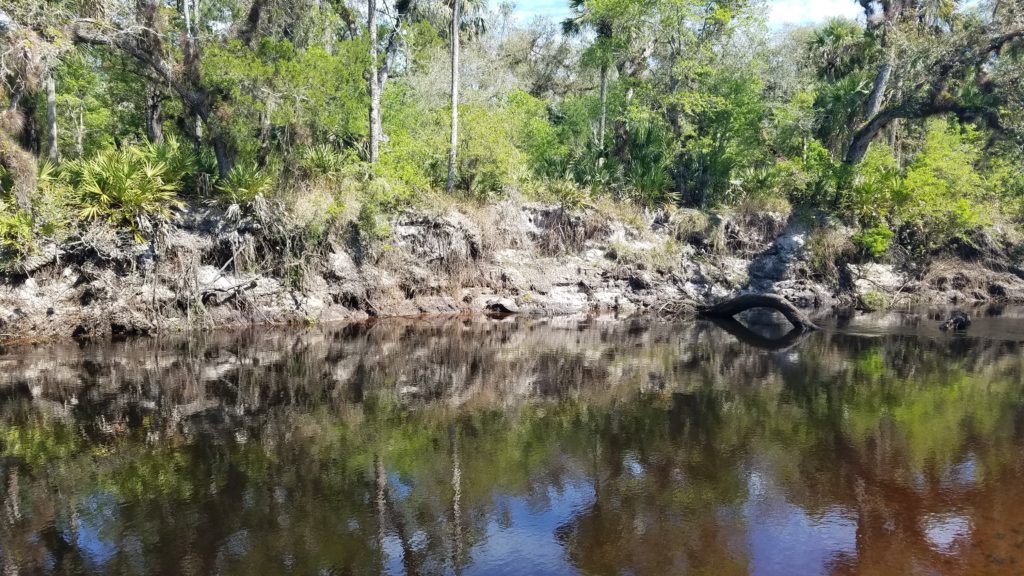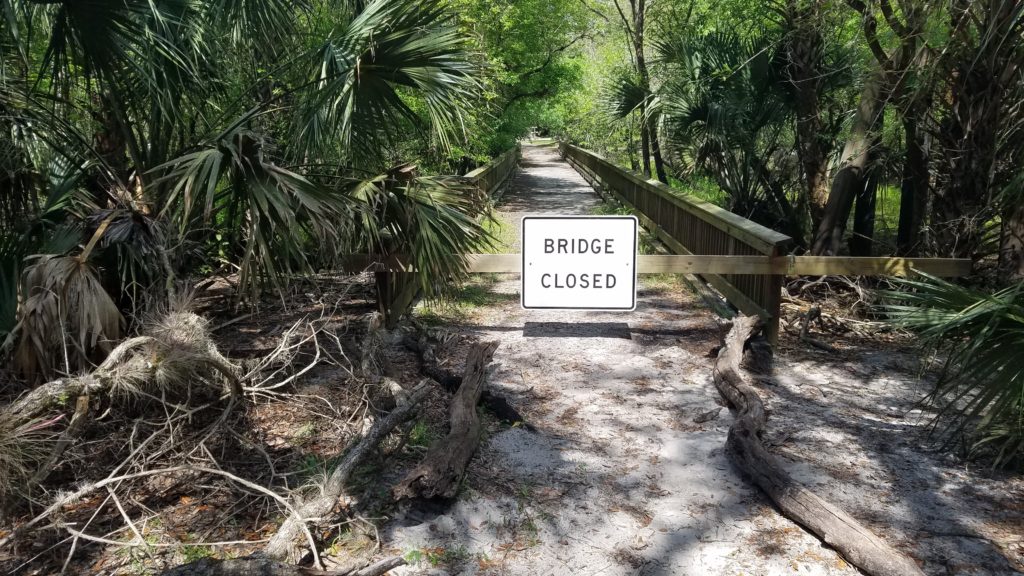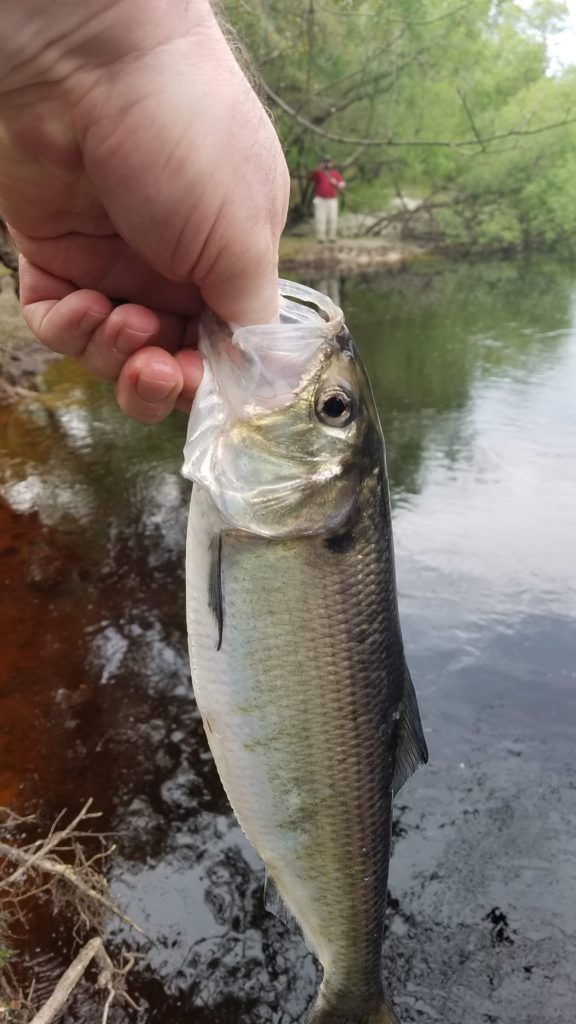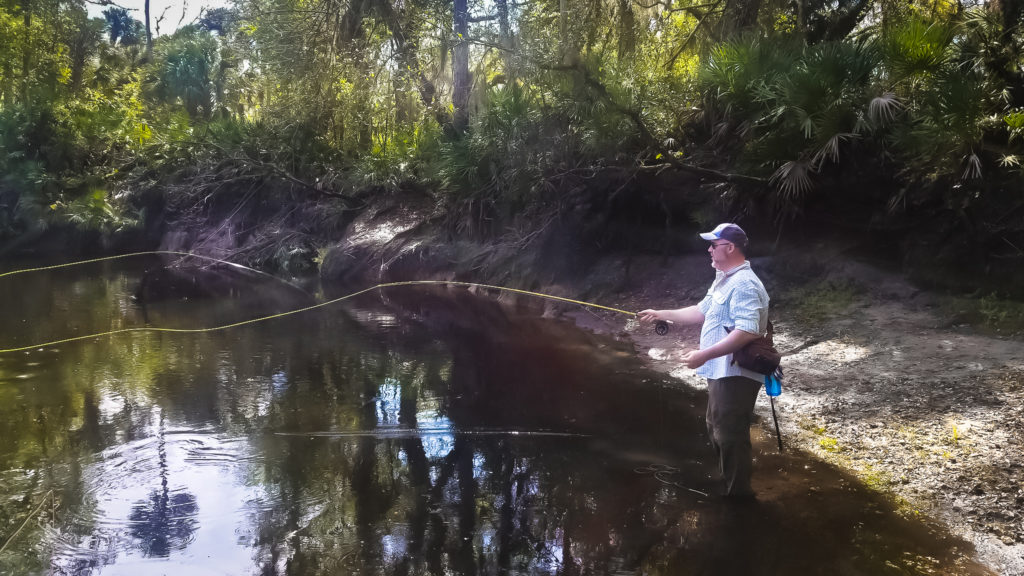
After taking a week off from shad fishing, I needed some time outdoors, and decided to make the hike upstream from Snowhill Road on Saturday. Recent rain had pushed the water up to about 3.5 feet on the Snowhill gauge, which is about a foot, to foot and a half higher than ideal for sight fishing, but fishable. I invited Ray to join me, and found out that he was already planning his first trip to this section of river, so we decided to team up.
We arrived at the river around 9:30 and made our way upstream, where we found another fisherman working one of the first bends for bass. We decided to give him room, and proceeded to hike along the river until we made our way to the pool that Todd and I call the double gator pool. Care to take a guess why? 🙂
The double gator pool has a feeder creek that dumps in to it, which creates a nice whirlpool eddy in its depth. The fish tend to sit outside of this current, and it is always a good spot to try. Interestingly, we did not find alligators here this trip, but did see a significant amount of surface activity. There is an opening at the water’s edge with just barely enough room for a backcast. Ray worked that area with the fly rod, and I opted to move slightly upstream to fish the head of the pool. With newly downed trees on the shore, and water levels higher than ideal, we found already confined quarters to be even more challenging, as comfortably wading to allow more space for a backcast was difficult.
One should note, that the Econ River upstream of Snowhill has a deceptive quality about it. While there are areas of white bottom “sand bars” that beckon to you like a Siren’s song… “wade in, come stand on me,” if you become too enchanted by the thought of better reach, you will quickly find that some of them are not sand bars at all, but quick sand! I have actually found myself in crotch deep sand before, which is creepy enough in clear, shallow water, and definitely something I would not want to do in an areas of river we fondly refer to as the double gator pool. Before you step, check… then check again.
Ray fished the area with the fly and had a take, but did not connect. I worked the head of the pool with the spoon for a while without a bite. Ray clearly spotted shad washing towards the inside of the bend, but outside of his reach, so I came over to take a shot with the spinning rod. After a few casts, I had a hard take followed by a solid run in to the drag. As I reeled in, the 7ft ultralight bent right down to the butt of the rod. Just as I said “man, this is a nice fish,” it made a strong run in to the drag and Ray shouted “it’s about to jump!” Right as I lowered the rod tip, we were both surprised by a leap in the air, and a tarpon like head shake… not from a shad, but by a GIANT gar that landed in the water like someone had thrown a bowling ball in to the river! Alas, the 6lb test on the ultralight was no match for the beast, and I broke him off before coming to hand. It looked to be the largest gar I have ever hooked.
I re-rigged as Ray took some more shots with the fly. After a few more casts in to the strike zone with the spoon, I managed to hook and land a shad that was very emaciated. While I was excited to answer the question as to whether shad had made it above Snowhill, this was also a sign that we are in to the tail end of the run. I switched to my 7ft fiberglass fly rod, and made some single hand spey casts in to the strike zone, but found no takers.
We continued upstream to an area I call the willow pool. It was a pool back in 2017, but the river has changed since then and the depth of the pool seems nonexistent. I would say its actually more of a soft bend now, so maybe I should call it willow bend… Ehhh, I still like pool.
Pool or no pool, there is still a head where there is decent current, and some trough like structure along the north bank. Just as prior years, fish were stacked up in this trough, and downstream of them, sat an alligator that will likely find plenty to eat as the fish continue to spawn and die off as water temperatures continue to rise.
An alligator on the shore is your best friend… better to be able to clearly see them than to wonder what all those bubbles are across the river from you. In the past I have made many casts directly in front of a beached gator, even plopping the fly right on top of them at times, hooked and landed fish, without even a flinch. Ray did just that, working the area directly in front of our pool mate, as I looked for a decent entry to fish the head of the pool. Again I found newly downed timber along the shore to further tighten already confined areas for a backcast, but I was able to manage, wading in about knee deep to make single hand spey casts to where I saw fish washing.
About that time we saw our first paddler, making his way upstream on the Econlockhatchee. Being a good man, he took care to move out of the way of where Ray was casting. Unfortunately on water this narrow, that meant he hugged the shore where the alligator was sunning himself, and it quickly slid in, not to be seen again. An alligator in the water is not your best friend, particularly in water this narrow, so back on shore we went. I switched back to the spinning rod, and after casting the spoon several times, watched two shad end up at my feet, even though I never saw them in the mud stained water I was casting to. They nipped but did not take.
Several more paddlers came by, spooking the pool… or bend, whatever you prefer. We decided to make the hike up to the pool downstream of the Flagler foot bridge, a solid bend in the river with good current at its head and tail. We found no fish, but did find more people. We continued up to the foot bridge, and I was surprised to see it was closed for renovation.
We half-heartedly fished the stretch just downstream of the bridge after a lunch break, but honestly just laughed because there were so many kids with their families, jumping and playing in the water, and paddlers coming downstream. With temperatures in the mid 80’s… at the beginning of March, who could blame them? We were sweating through our quick dry apparel, chasing a herring that swam a couple of hundred miles upstream on a freshwater river to spawn, until they were dead. I was starting to question why I didn’t bring a bathing suit so I could join them… the kids, not the spent shad! 🙂
Ray and I made our way back downstream, fishing the spots we already knew had fish, struggling to make casts, getting a few takes, and one more fish to hand. We watched more and more people paddle up and downstream and I have to say, I am pretty sure I saw more people on the water than I have ever seen above Snowhill in one day, even on a Saturday. We joked that the new neighborhoods in Geneva and Oviedo likely had something to do with it. Its probably true. More interest in the river, might end up meaning more respect for its riches, and that is never a bad thing. Time will tell.
As February fades away, and hopes of shad jumping in to boat at the mouth of the Econ do the same, consider this… there are still good numbers of fish upstream of Snowhill, Ray and I can surely attest. It is humbling to watch what they do unfold.. sometimes right outside of even a modest cast, but it is incredible all the same.
If you made it out to Brumley this year following reports of fish, I encourage you to now make the same journey with them upstream. In this new territory, you will find conditions tight, technical, and challenging… distinctly different than the conditions found further downstream. Backcasting is difficult if not impossible in a lot of the areas you will find fish. This is single hand spey casting water at its finest. Short rods, versus long switch rods, shine here. If spey casting is not your thing, a conventional rod is a good choice too.
As the water drops below three feet, you will be able to see shad clearly, and sight fish for them. You will watch them chase a fly, and turn a cheek, just as selective as any western trout, or discerning Bahamian bonefish. But with the right fly and presentation, you will catch them, and you might even be able to do so until April!
